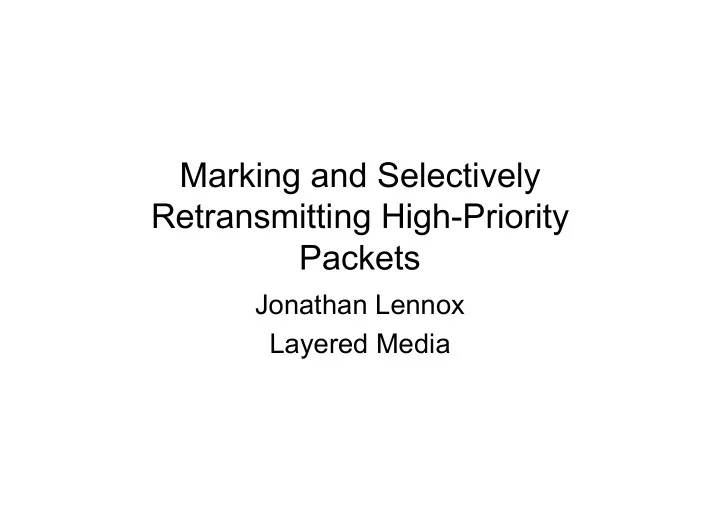

Marking and Selectively Retransmitting High-Priority Packets Jonathan Lennox Layered Media
“Note Well”: • Layered Media has potential IPR on this proposal. • If it’s accepted as a standards-track document, we’ll license on the basis of reciprocity. • See https://datatracker.ietf.org/public/ipr_detail _show.cgi?&ipr_id=726
Motivation R R R R • It’s possible to construct a packet stream so only a subset of the packets are needed for decoder state. – E.g. only need I frames and long-term reference frames. • If an intermediate packet (yellow) is lost, a decoder can recover. • The subset packets (“R Packets”, purple) are far enough apart (>1 RTT) to be recoverable. • Want to detect and recover missing R packets as soon as possible.
Requirements • Mark a subset of the packets as R packets. • Detect a missing R packet as soon as any stream packet is received. • Receiver can know whether any R packets are lost (and if not, take no action) no matter how many non-R packets are lost. • R packets can supersede previous R packets, marking them no longer needed. • Independent of codec structure. • Multiple series of R packets.
Named extension header • Mark packets with a named extension header (ietf-avt-rtp-hdrext): “org.ietf.avt.r-packet/200606”.
Header extension 0 1 2 3 0 1 2 3 4 5 6 7 8 9 0 1 2 3 4 5 6 7 8 9 0 1 2 3 4 5 6 7 8 9 0 1 +-+-+-+-+-+-+-+-+-+-+-+-+-+-+-+-+-+-+-+-+-+-+-+-+-+-+-+-+-+-+-+-+ | ID | len |R| MBZ | SER | RSEQ | +-+-+-+-+-+-+-+-+-+-+-+-+-+-+-+-+-+-+-+-+-+-+-+-+-+-+-+-+-+-+-+-+ | SUPERSEDE_START [opt] | SUPERSEDE_END [opt] | +-+-+-+-+-+-+-+-+-+-+-+-+-+-+-+-+-+-+-+-+-+-+-+-+-+-+-+-+-+-+-+-+ • ID, len – common header of named extension • R – is this an R packet • SER – series of the R packet • RSEQ – index of this R packet (R = true) / of most recent R packet in series (R = false) • SUPERSEDE_* – whether this R packet supersedes earlier ones – Optional; presence indicated by length field
Example … R: true R: false R: false R: true R: false R: false R: true R: false R: false R: true … RSEQ:1 RSEQ:1 RSEQ:1 RSEQ:2 RSEQ:2 RSEQ:2 RSEQ:3 RSEQ:3 RSEQ:3 RSEQ:4 • R packets have R = true, increment RSEQ by 1. • Non-R packets have R = false, RSEQ of previous R packet.
Example 2: Superseding RSEQ:3 RSEQ:4 RSEQ:5 RSEQ:6 RSEQ:7 RSEQ:8 RSEQ:9 S’cede: S’cede: S’cede: S’cede: 4 - 2 5 - 5 10 - 7 10 - 7 • R packets can supersede previous R packets: superseded ones no longer need to be received. • R packets can either supersede a few previous R packets (explicit range) or all (start = seq + 1). • If several R packets together supersede previous packets, they carry the same supersede range.
AVPF feedback packet: RNACK • When an R packet is lost, send AVPF feedback message RNACK (R-packet negative acknowledgement): RTPFB, FMT=4. 0 1 2 3 0 1 2 3 4 5 6 7 8 9 0 1 2 3 4 5 6 7 8 9 0 1 2 3 4 5 6 7 8 9 0 1 +-+-+-+-+-+-+-+-+-+-+-+-+-+-+-+-+-+-+-+-+-+-+-+-+-+-+-+-+-+-+-+-+ | RSEQ | SER | BLR | +-+-+-+-+-+-+-+-+-+-+-+-+-+-+-+-+-+-+-+-+-+-+-+-+-+-+-+-+-+-+-+-+ • Similar to Generic NACK – ID of lost packet, bitmap of following lost packets. – Uses R sequence numbers. – Mentions series of R packets lost.
Open questions • Is this a useful problem to solve? • Is this the best way of solving this problem? • Is the working group interested in seeing this developed further?
Recommend
More recommend